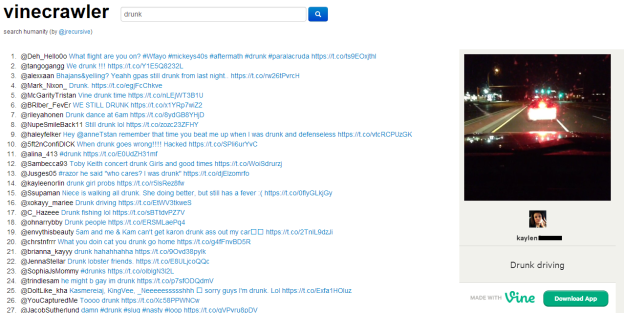
While it’s proven plenty popular, there’s still only so much we can all do with Vine. The app’s API hasn’t been publicly released yet, and developers have been anxious to test out their chops, but we’ve already seen a couple of examples of some ideas that developers have hacked while waiting for the official API. The latest third-party Vine app comes by way of John Mullerleile, who’s developed Vinecrawler, a rudimentary (but working) search engine of Vine videos.
Even for such a short amount of time, digging through this Vine search engine can surface funny and sometimes damaging NSFW videos, which include drunkenness, kids claiming gang affiliations, and people #Twerkinit. Since Vinecrawler just digs through keywords, you’re going to get something from searching for a term.
Vinecrawler however isn’t exactly a complete search engine. Without the API on hand and approved by Twitter HQ, Mullerleile, like every other developer that released a third-party Vine app, is working with a limited amount of data.
Still, it’s an impressive effort (and a fun one for us to enjoy). Mullerleile created Vinecrawler by taking an a similar approach to the developers of VineRoulette and VinePeek. An algorithm does the heavy lifting of scouring tweets to find all keywords with the word “Vine” somewhere in these tweets. In Mullerleile’s case, the data mining took him 10 days, and four million tweets later he’s created a fairly thorough catalog.
All he had to do then was organize this information into a tidy looking graphical user interface, a semblance of a search engine. A nice touch that he adds to Vinecrawler is a right-column preview of the Vines that show up in the results.
In developing Vinecrawler, Mullerleile has done Vine users a service as the platform itself isn’t geared toward content discovery just yet. Mullerleile explains in his blog post that he simply wanted to know more about Vine as a platform, and who was using it.
What he’s found is that he can’t quite pinpoint the typical Vine user. Users come from “All different walks of life, geographies, incomes; all genders, ages, races, backgrounds,” he says. “They use it in all kinds of ways, sometimes hilarious, ridiculous, or strange, but all decidedly human. There is also some kind of fixation with Jay-Z, and I approve.”
Mullerleile concludes that since he’s come to the realization that all types of people are using Vine, he’s not surprised that the app has spread everywhere. “It’s natural, fundamentally intuitive to use, possibly magical in operation, like magnets, or gravity, or maybe even a little bit like life.”
Editors' Recommendations
- How to get verified on Instagram Threads
- Elon Musk invites Twitter complaints, gets 83,000 replies
- How to use Twitter Advanced Search
- How to search Twitter by date
- Want better Twitter notifications? New keyword search alert could help


